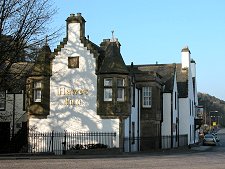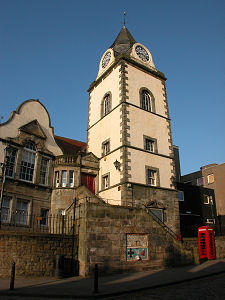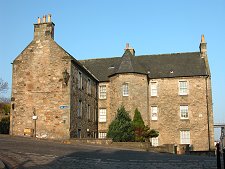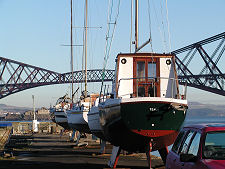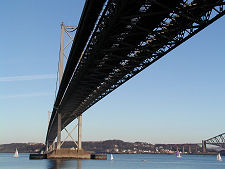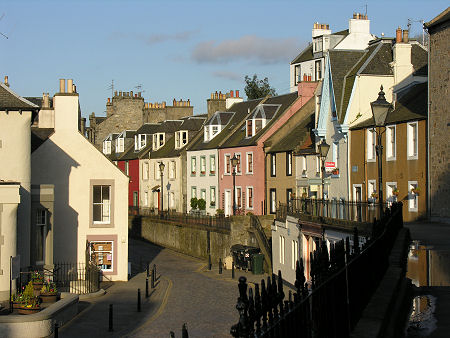 Queensferry High Street from the West |
Queensferry, sometimes also called South Queensferry, sits on the south shore of the narrowest part of the Forth Estuary east of Grangemouth, looking across to North Queensferry, its twin on the Fife shore. As an obvious place to cross the river when heading into Fife from Edinburgh it is likely that settlements either side of the river here, and ferries between them, date back to ancient times.
The "Queen" in Queensferry was Queen Margaret, the wife of Malcolm III. She set up a church in Dunfermline, where she had married Malcolm in 1070. This rapidly became a place of pilgrimage leading to increasing demand for transport across the Forth Estuary. The Queen's Ferry, paid for by Margaret and operated by monks from Dunfermline, was the result. This had no fixed southern terminal, using a variety of landing places in or near the village depending on the tide and weather.
In 1879 construction began on a railway suspension bridge across the narrows here. This had been designed by Thomas Bouch, builder of the Tay Railway Bridge that opened in 1878. The collapse of the Tay Bridge with large loss of life on 28 December 1879 brought a halt to work on Bouch's Forth Bridge. The Forth Rail Bridge that was finally built between 1883 to 1890 was designed by Sir John Fowler and Benjamin Baker and is a testament to conservative over-engineering.
With the coming of the internal combustion engine, the ferries grew again in importance. By the 1950s the ferry across the Queensferry Passage was the busiest in Scotland, with four ferries making over 40,000 crossings each year and carrying 1.5 million people, 600,000 cars and 200,000 goods vehicles. In 1956 it cost between 2/6d and 7/6d for a car, and between 4/6d and 54/- for a lorry. The cost for a passenger was 5d.
Between 1958 and 1964, Queensferry acquired its second world class bridge, the Forth Road Bridge. When this was opened by the Queen on 4 September 1964 the ferries ceased after nearly 900 years of operation. Bridge tolls stood at £1.00 for a car, charged northbound only, when they were abolished altogether on 11 February 2008. Problems with the bridge have led to the building of a second road bridge, the Queensferry Crossing, a little to the west of the earlier one, which opened in 2017.
Queensferry is defined by the road and rail bridges that lie either side of it. But it is so much more as well. At times it has been an important trading and fishing port in its own right and the town still offers an environment that can transport you back to an earlier time more readily than most places in Scotland. If, that is, you can catch it in a rare traffic-free moment: cars are constrained by the narrowness and twistiness of Queensferry's High Street, and as a result intrude far more than elsewhere.
Queensferry offers one of the most interesting collections of buildings you are likely to find anywhere. The oldest is St Mary's church, which dates from 1441. The oldest house is "Black Castle", built on the High Street in 1626. When the sea captain it was built for was lost with his ship, his maid was accused of paying a beggar woman to cast a spell on him. Both women were burned for witchcraft. The nearby Tolbooth was built in the 1600s, though the tower dates back only to 1720.
The High Street itself has an unusual stepped cross section designed to cope with the town's steeply sloping site above the shore. This has led to elevated pavements on the inland side of the street, again adding to the atmosphere. For all the very obvious reasons, plus its proximity to Edinburgh, Queensferry is an extremely popular place and at times can be a crowded one. It is worth making an effort to try and catch it at a quiet time: that way you can still catch glimpses of the Queensferry of the 1700s that Robert Louis Stevenson featured in "Kidnapped".
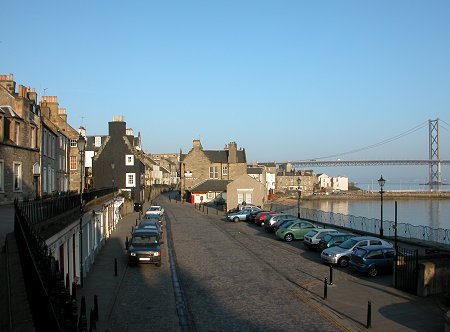 Queensferry High Street from the East |

|
|
|
Visitor InformationView Location on MapWhat3Words Location: ///decide.booms.rating |
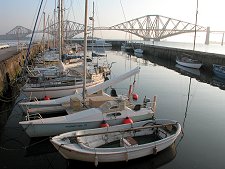 Harbour and Rail Bridge |
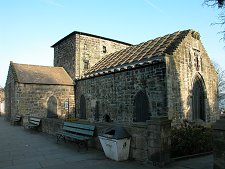 St Mary's Church |
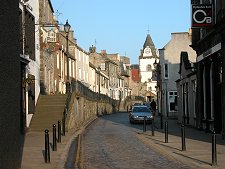 High Street |
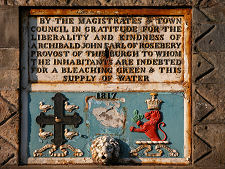 Plaque on the Tolbooth |
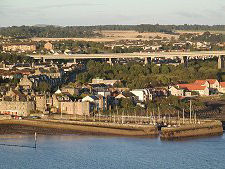 Queensferry from the Rail Bridge |
